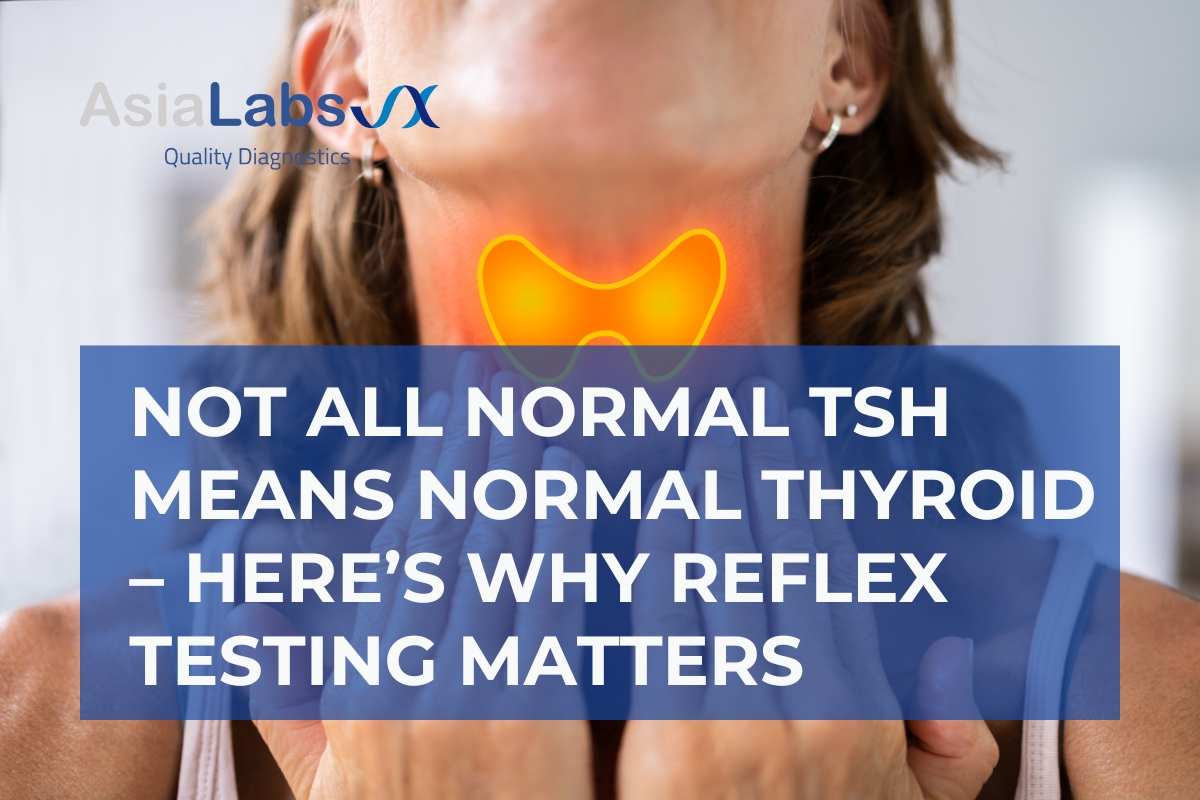When a patient presents with classic symptoms of thyroid dysfunction—fatigue, hair thinning, unexplained weight changes—but their TSH comes back within the reference range, it’s tempting to rule out thyroid disease and look elsewhere. However, a “normal” TSH does not always mean a healthy thyroid. Relying solely on TSH can miss subtle or evolving thyroid disorders, especially in symptomatic patients or those at higher risk.
The Limits of TSH as a Standalone Marker
TSH (thyroid-stimulating hormone) is a powerful screening tool and the primary test for assessing thyroid function. Most laboratories define the normal range as roughly 0.4–4.0 mIU/L, though some guidelines suggest the upper limit should be lower, particularly in younger adults and women. TSH is highly sensitive to changes in circulating thyroid hormones, and small deviations can signal early thyroid dysfunction. However, there are important caveats:
-
TSH reflects pituitary response, not tissue-level thyroid status: TSH is regulated by the pituitary gland’s perception of circulating thyroid hormones, mainly T4. But this doesn’t always mirror what’s happening at the tissue level, where thyroid hormone action actually matters2.
-
Reference ranges are population-based: The “normal” range is statistically derived, meaning some individuals with symptoms may still fall within these limits, particularly if their personal baseline is at one end of the spectrum.
-
TSH can be affected by age, medications, illness, and even time of day: These factors can mask or mimic thyroid dysfunction, complicating interpretation.
When Normal TSH Isn’t Enough
Several thyroid disorders can be missed if TSH is the only test performed:
| Condition | TSH Result | Other Findings |
|---|---|---|
| Subclinical hypo/hyperthyroidism | Normal or borderline | FT4 and/or FT3 slightly abnormal |
| Central (secondary) hypothyroidism | Low or normal | FT4 low, TSH inappropriately normal |
| Early autoimmune thyroiditis | Normal | Positive anti-TPO, fluctuating FT4 |
| Tissue-level hypothyroidism | Normal | Symptoms persist, low FT3 or T3/T4 ratio |
For example, in central hypothyroidism (a pituitary disorder), TSH may be normal or even low, while FT4 is decreased—something easily missed without reflex testing. Early Hashimoto’s thyroiditis can present with normal TSH but positive thyroid antibodies and subtle symptoms.
Reflex Testing: A Smarter Approach
Recognizing these limitations, AsiaLabs has implemented reflex testing protocols to improve diagnostic accuracy and reduce missed thyroid cases:
-
If TSH is borderline or the patient is symptomatic, FT4 and FT3 are automatically triggered.
-
If hypothyroid features persist, anti-TPO antibodies are added to detect early autoimmune disease.
This approach is supported by clinical evidence showing that restricting FT4 measurement to only those with abnormal TSH can miss up to 31% of relevant thyroid disorders, especially in women over 35 or those with a history of autoimmunity.
Why Reflex Testing Matters
-
Increases diagnostic yield: More cases of subclinical or central thyroid disorders are detected, reducing the risk of misdiagnosis and delayed treatment.
-
Reduces unnecessary referrals: By providing a fuller picture up front, clinicians can avoid unnecessary specialist visits or repeated blood draws.
-
Improves patient outcomes: Early detection of thyroid dysfunction allows for timely intervention, which is especially important in pregnancy, elderly patients, or those with cardiovascular risk.
AsiaLabs: Speed, Transparency, and Clinical Support
AsiaLabs supports clinicians with:
-
Same-day turnaround for all thyroid panels, minimizing delays in care.
-
Digital alerts for abnormal result combinations (e.g., high FT4 with low TSH, suggestive of hyperthyroidism).
-
Pre-analytical flags to highlight sample or timing issues that could affect interpretation.
Rethinking “Normal”
Emerging research suggests that even TSH values in the high-normal or low-normal range may be associated with increased risk of cardiovascular events or mortality, especially in older adults. This challenges the notion that “normal” always means “healthy,” and highlights the need to interpret TSH in context—considering symptoms, risk factors, and additional thyroid markers.
Practical Takeaways for Clinicians
-
Don’t dismiss symptoms just because TSH is normal. Consider the full clinical picture and use reflex testing when warranted.
-
Be aware of patient-specific factors: Age, sex, pregnancy, and comorbidities can all influence what is “normal” for TSH and thyroid hormones.
-
Educate patients: Explain why additional tests may be needed even if their initial TSH is within range.
Conclusion: Dig Deeper for Better Thyroid Care
A normal TSH result is reassuring, but it’s not the end of the story—especially for patients with persistent symptoms or risk factors for thyroid disease. Reflex testing protocols, like those at AsiaLabs, empower clinicians to dig deeper, catch subtle or early thyroid dysfunction, and provide more personalized care.
Normal doesn’t always mean healthy. With AsiaLabs’ reflex testing, you can be confident you’re not missing what matters most.

